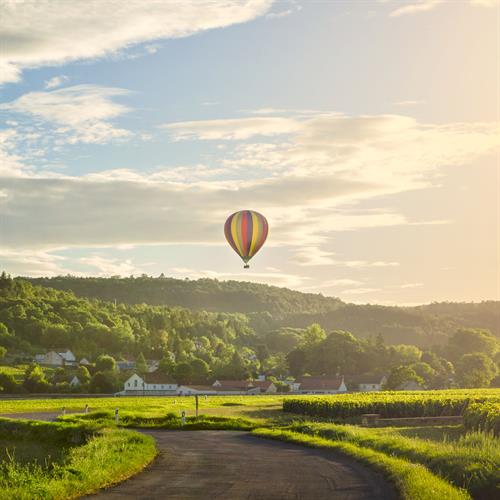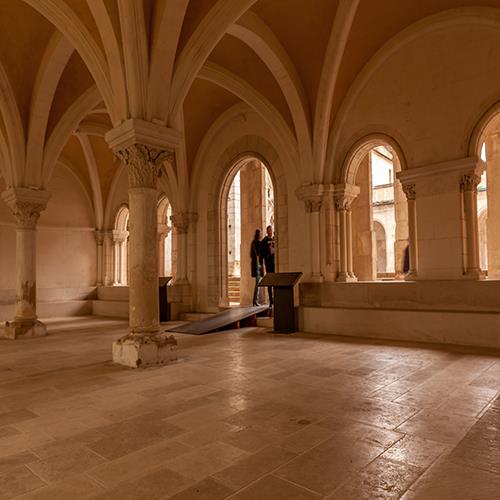EXPERIENCE BURGUNDY

Overview
Burgundy’s landscape is as unforgettable as its food and wine. There is fabulous architecture dating back to the Renaissance, and in some cases the Middle Ages. You'll also find acres upon acres of wild, protected landscapes in the Morvan National Park and numerous picturesque cities, towns and villages to explore, each with their own charms. UNESCO World heritage listed Vézelay is a perfect example, boasting beautiful architecture dominated by a medieval basilica, below it a fantastic stretch of vineyards and field of sunflowers.
In Burgundy (or Bourgogne as the French call it), there are thousands of amazing small scale producers of both red and white wine. Undoubtedly the most commonly grown grapes in Burgundy are Pinot Noir (red) and Chardonnay (white). Although Burgundy might sound red to English-speakers, more white wine is produced here than red. Domaines are the norm in Burgundy. The Côte d'Or is probably Burgundy’s most famous wine growing region, a beautiful spot between Dijon and Beaune including Meursault and the long, scenic corridor on the bank of the Saône river designated Beaujolais.



Architecture
Burgundy is steeped in history associated with its architecture, and as you explore, the outdoor cities, towns and villages become their own museum, decorated with architecture that dates back to its Roman occupation in the 50’s AD. Autun was built to look like Rome and features the 2,000 year-old Temple of Janus and Roman theatre, as well as two still-standing gates and the city wall.
In the city of Beaune, you'll discover well-preserved examples of gothic architecture, including the Musee de L'Hotel Dieu des Hospices de Beaune, a medieval hospital built in 1443. The Burgundy Wine Museum is housed in the 13th-century former residence of Burgundy's dukes. Here, you can find Burgundian architecture and Burgundian Burgundy at the same time. The Collegiale St. Lazare in Avallon, with its watchtowers and ramparts, represents 11th-century architecture.
The town of Noyers boasts 13th century architecture, it’s like stepping back in time. The Abbey de la Bussiere is a restored 12th-century abbey now open for retreats, tours, and other gatherings. View it inside and out for an up-close inspection of Burgundian architecture.
For a look at some natural architecture enhanced by the hand of prehistoric artists, visit the Caves of Arcy-sur-Cure between Auxerre and Avallon. River-formed limestone towers and grottos are decorated by over 140 primitive paintings of animals and geometric designs, making the caves the second oldest known painted caves in the world.



Shopping and Markets
Of course Burgundy is famous for its wine, but it also has a reputation for its mustard (moutarde in French). Dijon, the capital city of Burgundy, is home to some gourmet mustard shops, and the mustards are not all yellow. Discover all the different types of mustards being sold on the streets (at food stalls), and just about every store. Visit 32 Rue de la Liberté to find the Maille mustard store, where you can sample many varieties of Dijon mustard.
As you explore the region you’ll find craft shops, antiques, clothes and of corse Burgundian cheese. Other local specialties of Burgundy include pain d'épices, a spice bread that's very popular in Dijon, and of course escargots - packed in cans. You’ll also find the usual hand towels, aprons, tee shirts, and other souvenirs available in many shops.
Dijon's main shopping street is the Rue de la Liberté, a lovely pedestrian street that runs between the Place de la Libération and the Porte Guillaume, near the Place D'Arcy. A variety of colorful flags extend from the buildings and the area is always busy with shoppers and visitors.
On Rue de la Liberté you'll find everything from clothes stores and pharmacies to stores specializing in mustard and local wine and crème de cassis (black current liqueur used to make kir). There's even a large Galéries Lafayette, one of France's major department stores.
While in Dijon, be sure to visit the wonderful market, or Les Halles, even if only to enjoy the sights and aromas. The Halles is housed in a beautiful old cast iron building from the late 1800s. Modeled after the old Halles of Paris, this structure is the center of a lively area of shops and restaurants.
The full market takes place on Tuesdays, Fridays, and Saturdays, and on these days the area outside the Halles building and the surrounding streets are packed full of vendors selling produce, clothing, souvenirs, and much more. On Thursdays only the markets inside the Halles are open, with their delicious offerings of meats, cheeses, and produce.
You'll see a lot of things here that you'll find on menus in Burgundy: lots of beef for boeuf bourguignon; chicken for coq au vin; jambon persillé (ham and pork in a terrine, covered with a parsley gelatin); and of course a wide assortment of cheeses.

Wines
Burgundy's red and white wines, especially those of the Côte d'Or vineyards, which include Côte de Nuits and Côte de Beaune, are world-renowned. But you’ll also want to find time to explore some of the other more relaxed appellations. Beautiful Irancy is a favorite tasting region for many locals. Nearby Chablis, with its crisp white wines, is wonderful on a hot summer day. To really get off the beaten path, head to the Mâconnais and Châtillonnais vineyards.
Although Burgundy is covered in vineyards, not many areas offer organized tours of the wineries. The best hubs for picking up a tour are Dijon, Beaune and Chablis.


Museums and Attractions
Burgundy is wine country and the Burgundy Wine Museum, housed in the residence of Burgundy's former dukes, offers an excellent opportunity to explore the history and culture of France's most prolific wine-producing region. Even with a name like Burgundy, however, the region is not all about wine.
The Museum of Arts and History in Auxerre features flintstone tools and artifacts from Burgundy's prehistoric times, as well as items unearthed from its more recent (though still ancient) Gallo-Roman period. The Saint Germain Abbey, also in Auxerre, contains tombs from the Carolingian period bearing 9th-century frescoes, the oldest in the country.
Near to Beaune, Burgundy's capital city, is the Museum of Celtic Civilization, a new cultural attraction that exhibits both locally-discovered objects and reproductions from other European archaeological digs. The Fine Arts Museum is housed in the former Burgundy State Palace and holds the tombs of Phillip the Bold and John the Fearless, rulers of the Burgundian Kingdom in its glory days (pre-mid).
The Wine Route, between Dijon and Santenay, is 30 miles of the most intoxicating road you may ever travel. Some of the best wines in the world are produced there including Chardonnay, Chablis, and Sauvignon. You can drive it yourself or book a tour.
Burgundy is also home to numerous churches and abbeys. One of them worth visiting is the Notre Dame Church in Dijon. The church, built in the 13th century, is of gothic design and features gargoyles, unusually thin columns, and the Jacquemart Clock.


History
Burgundy is steeped in history, where a large collection of flintstones have been discovered throughout the area. Archaeology has revealed that, over time, the area's inhabitants, originally hunters, added farming and agriculture to their talents. This caused the once mobile population of the area to settle and increase.
The territory which would eventually become Burgundy, was conquered by Julius Caesar and his armies between 58 and 51 BC. As the Roman Empire fell, Germanic tribes began to invade. Around 480, the Burgundii, a tribe from Savoy, conquered the area, forming the First Kingdom of Burgundy. This lasted until 534, when the Franks invaded and conquered the kingdom and divided it several times. Eventually, two Burgundian kingdoms were founded: Provence, located in the south, and Transjurane Burgundy in the northern section. In 933 these two kingdoms were reunited into the Second Kingdom of Burgundy.
Present-day Burgundy was created as the Duchy of Burgundy in 877, though its succession of rulers, over time, acquired much territory, including the Netherlands and Belgium. By the fifteenth century, Burgundy was a focus of French politics, trade, industry, and agriculture, as well as art. In the late 1400s, French King Louis XI seized Burgundy and it became a province of France.
Burgundy eventually became known as wine country, and is France's most prolific producer of the fruit of the vine.


Events and Festivals
Burgundy is known for its wines and mustards (thanks to Dijon), and also for its plethora of festivals throughout the year. The Wine and Folklore Festival of Baroque Music encompasses three themes into one big festive party. The festival takes place in early September and is celebrated in Dijon and several other Burgundy towns.
The city of Beaune hosts an amazing Bread, Wine and Cheese Fair in October. What’s not to love about this annual event. You’ll also find several wine-tasting events, tours and fairs that take place throughout the year in Burgundy. One is the Wine Festival in Nuits Saint George, and another is the Hospices Wine Auction in Beaune. If you are visiting in June, check out the Tree Art Festival in Chalon sur Saone. And in July, enjoy the Jazz Festival in Couches.
Cirque Plume takes place in October in Chalon sur Saone and is not to be missed. Dijon has a flea market in early October, an International Gastronomic Fair in November, and a Spice Bread Festival in December. As you can see, the area is jammed packed with festivities throughout the year!